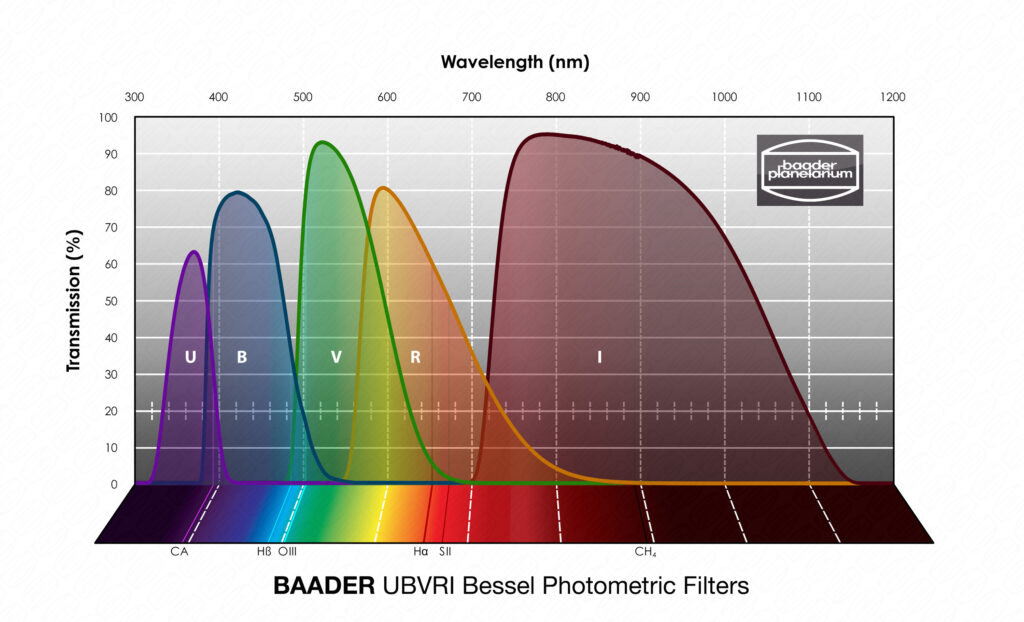About this product
Model: baader_2961753
Part Number: 2961753
The UBVRI system was developed in the 1950s for the 0.9m McDonald Observatory telescope and initially consisted of a Johnson UBV filter set, later extended by Cousins to include the R and I filters for the red region of the spectrum. The filters of the extended UBVRI system according to Johnson and Cousins include:
- U – Ultraviolet, with a transmission window between about 320 and 400 nm
- B – Blue, with a transmission window between about 400 and 500 nm
- V – Visible, with a transmission window between about 500 and 700 nm
- R – Red, with a transmission window between about 550 and 800 nm
- I – Infrared, with a transmission window between about 700 nm and 900 nm.
According to the state of the art at that time, the filters had different thicknesses and transmittance values as well as no sharply defined edges (if any). Their spectrum therefore corresponds to a curve instead of a plateau.
Bessel filters for the digital age
In 1990, M. S. Bessel looked into the subject in order to find a filter combination for the new CCD cameras that were becoming increasingly widespread at the time. These Bessel-UBVRI filters are still standard today and are also the most widely used in amateur circles such as the AAVSO. The V-filter in particular has proved to be an inexpensive introduction to photometry: It corresponds approximately to the visual brightness; since only one measured value is used, this is optimal for getting to know the techniques.
Since 2010, Baader Planetarium has offered photometric UBVRI filters according to Bessel, which protected the coloured glasses from ageing with a dielectric coating and at the same time provided the desired transmission properties. This is not at all a matter of course: unfortunately, comparisons by the AAVSO have shown that not every modern "Bessel filter" actually shows the irregular flanks of genuine Bessel filters, but instead there are often plateaus with steep flanks. These steep slopes are easily achievable with dielectric filters, but the data obtained with them are simply not comparable, or only with difficulty, with the old data sets. Compare for yourself: You can find the transmission spectra in the product description.
New generation of Baader Planetarium UBVRI filters
We could not further improve the characteristics of our previous, Bessel-compatible UBVRI filters - but we could make the filters better. The new generation of Baader Planetarium UBVRI filters, introduced at the end of 2021, is a modern filter set that is both fully compatible with the characteristics of the original Bessel filters and at the same time meets modern demands for contemporary filters:
- The photometric filters now have the same thicknesses as all other Baader filters:
- 2 mm filter thickness for all filters up to size 2" mounted (1.25", 31 mm, 36 mm, 2")
- 3 mm filter thickness for all sizes above (50.4 mm, 50 x 50 mm, 65 x 65 mm)
- This means that they fit into any commercially available filter wheel, for which the original filters were often simply too thick and could not be fixed securely.
- They are parfocal with all other Baader filters of the same size and now also available in sizes up to 100x100mm - large enough even for modern, professional sensors, or optimal for easy handling in the common filter mounts for amateur telescopes.
- The coating of all photometric filters is manufactured in the same technology as the CMOS-optimized narrowband and LRGB filters. The lifetime Life-Coat™ guarantee also applies here.

Customer reviews
FAQ
Please fill in the form below to ask a question.